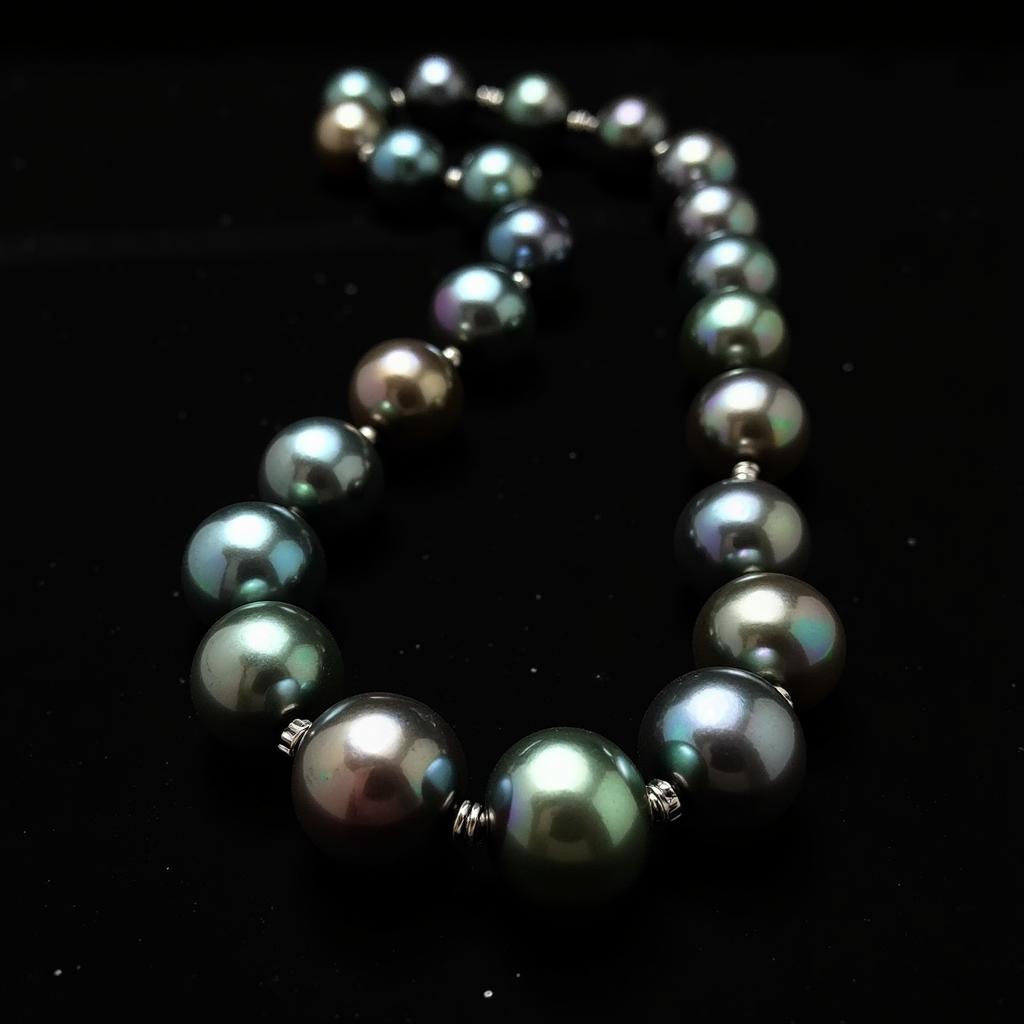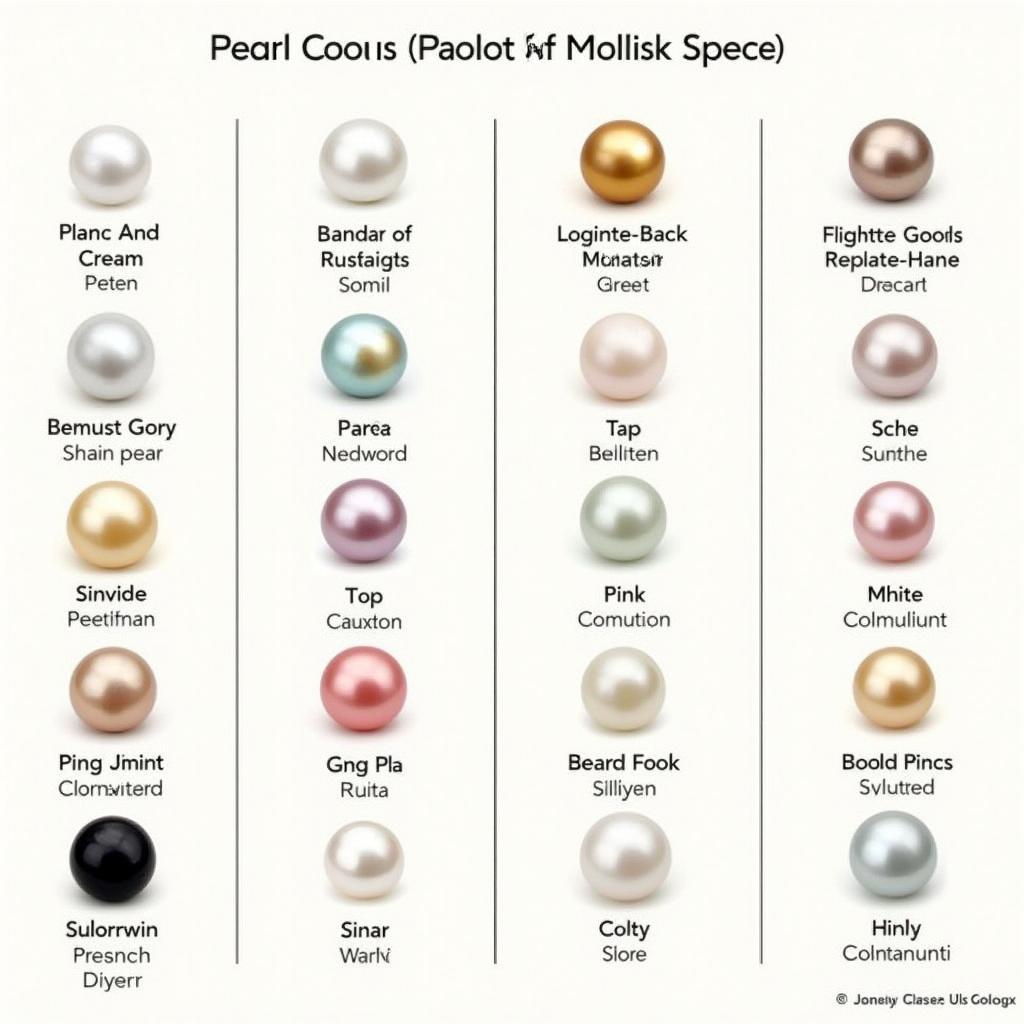Pearls, those luminous gems born from the depths of the ocean, are often associated with a classic, creamy white. But what color can pearls be, really? The truth is, the world of pearl colors is far more diverse than many realize, spanning a breathtaking spectrum from shimmering silvers and golds to soft pinks, vibrant greens, and even deep blacks. Let’s dive into the fascinating world of pearl colors and explore the factors that influence their captivating hues.
Pearls are created when an irritant enters a mollusk’s shell, and the creature coats it with layers of nacre, also known as mother-of-pearl. This nacre is what gives pearls their unique luster and color. The type of mollusk, the water conditions, and even the irritant itself can all play a role in determining the final color of the pearl. You can find out more about the variety of pearl colors at what colors can pearls be.
The Rainbow of Pearl Colors: A Spectrum of Beauty
From the ethereal glow of white pearls to the mysterious allure of black Tahitian pearls, the range of pearl colors is truly remarkable. Let’s explore some of the most common and sought-after pearl hues:
Classic White and Cream Pearls: Timeless Elegance
White and cream pearls are the quintessential pearl colors, often associated with purity, grace, and sophistication. These classic hues are versatile and complement any skin tone, making them a popular choice for jewelry.
Silver and Gray Pearls: Modern Sophistication
Silver and gray pearls offer a cool, contemporary twist on the classic pearl. These shades exude a subtle elegance and can add a touch of understated glamour to any outfit.
Golden Pearls: Warmth and Luxury
Golden South Sea pearls, with their rich, warm tones, evoke a sense of luxury and opulence. These pearls are prized for their rarity and their ability to complement warmer skin tones beautifully.
Pink Pearls: Romance and Femininity
Pink pearls, with their delicate and romantic hues, are often associated with femininity and grace. These pearls can range from soft blush tones to vibrant rose hues, offering a variety of options for those seeking a touch of color.
Black Pearls: Mystery and Allure
Black Tahitian pearls are known for their exotic beauty and mysterious allure. These pearls are cultivated in the black-lipped oyster and exhibit a range of dark hues, from deep black to peacock green and even silver. Are you curious about the colors of other gems? Check out our article on how many colors of gold are there.
 Black Tahitian pearl necklace showcasing the iridescent colors
Black Tahitian pearl necklace showcasing the iridescent colors
Factors Influencing Pearl Color: Nature’s Artistry
The color of a pearl is influenced by a complex interplay of factors, including the type of mollusk, the environment, and the nacre itself.
The Mollusk: The Architect of the Pearl
Different species of mollusks produce pearls of varying colors. For instance, Akoya pearls are typically white or cream, while South Sea pearls can be white, cream, silver, or golden.
The Environment: A Painter’s Palette
The water’s temperature, salinity, and nutrient content can all affect the color of the pearl. For instance, pearls grown in warmer waters tend to have richer, more vibrant hues. Wondering if other shellfish can create pearls? Find out if can clams make colored pearls.
Nacre: The Essence of Luster and Color
The thickness and composition of the nacre layers also contribute to the pearl’s color. Thicker nacre layers generally result in pearls with a more intense and saturated color.
 Pearl color chart showing different types of mollusks and their corresponding pearl colors
Pearl color chart showing different types of mollusks and their corresponding pearl colors
Choosing the Perfect Pearl Color: Expressing Your Unique Style
With such a wide range of colors to choose from, selecting the perfect pearl can be an exciting journey of self-expression. Consider your skin tone, personal style, and the occasion when choosing your pearl jewelry.
“The beauty of pearls lies in their individuality. Each pearl is a unique creation of nature, possessing its own distinct character and charm.” – Eleanor Vance, Gemologist.
Conclusion: Embracing the Diversity of Pearl Colors
From the timeless elegance of white pearls to the exotic allure of black Tahitian pearls, what color can pearls be? The answer is a mesmerizing spectrum of hues, each with its own unique beauty and story. Embrace the diversity of pearl colors and discover the perfect gem to reflect your individual style and personality. If you’re considering adding a splash of color to your wardrobe, our article on what color is caviar clothing might inspire you.
FAQ
- What is the most common pearl color? White or cream are the most commonly found natural pearl colors.
- Are black pearls naturally black? Yes, Tahitian pearls are naturally dark and can range in color from black to gray, green, and purple.
- What determines the color of a pearl? The type of mollusk, the environment it lives in, and the nacre composition all contribute to a pearl’s color.
- Are dyed pearls less valuable? Generally, natural pearl colors are more valuable than dyed pearls.
- How can I tell if a pearl is real? Real pearls will feel slightly gritty when rubbed against your teeth, unlike smooth imitations.
- What is the rarest pearl color? Blue pearls are considered exceptionally rare.
- How should I care for my pearls? Keep pearls away from harsh chemicals and store them separately to avoid scratching.
More Questions? Explore These Related Topics
Need Help? Contact Us!
For expert advice on pearl colors and selection, contact Color Box Hanoi!
Phone: 0373298888
Email: [email protected]
Address: 86 Cau Giay, Hanoi.
We have a 24/7 customer service team ready to assist you.

